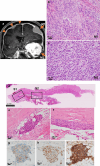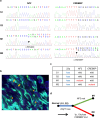Comprehensive genomic analysis reveals clonal origin and subtype-specific evolution in a case of sporadic multiple meningiomas
- PMID: 39066986
- PMCID: PMC11499534
- DOI: 10.1007/s10014-024-00486-9
Comprehensive genomic analysis reveals clonal origin and subtype-specific evolution in a case of sporadic multiple meningiomas
Abstract
Meningioma is the most common primary intracranial tumor in adults, with up to 10% manifesting as multiple tumors. Data on the genomic and molecular changes in sporadic multiple meningiomas are scarce, leading to ongoing debates regarding their evolutionary processes. A comprehensive genetic analysis of a large number of lesions, including precursor lesions, is necessary to explore these two possible origins: clonal and independent. In the present study, we performed whole-exome sequencing and analyzed somatic single-nucleotide variants (SNVs), insertions/deletions (INDELs), and copy number alterations (CNAs) in a patient with sporadic multiple meningiomas. These meningiomas included two mass-forming lesions of different histological subtypes (transitional and chordoid) and two small meningothelial nests. Genetic analysis revealed CNAs on chromosomes 22q and Y as common abnormalities in the two largest tumors. Furthermore, we identified SNV/INDELs unique to each focus, with NF2 mutation prevalent in the transitional meningioma and CREBBP mutation in the chordoid meningioma. Loss of chromosome 22 was detected in two small meningothelial nests. Overall, we elucidated the clonal origin and subtype-specific evolution of multiple meningiomas in this case. CNAs may serve as the initial driving event in meningioma development.
Keywords: Copy number alteration; Multiple meningiomas; Occult meningioma; Whole-exome sequencing.
© 2024. The Author(s).
Conflict of interest statement
The authors declare no conflict of interest.
Figures



Similar articles
-
Whole exome sequencing in a case of sporadic multiple meningioma reveals shared NF2, FAM109B, and TPRXL mutations, together with unique SMARCB1 alterations in a subset of tumor nodules.Cancer Genet. 2015 Jun;208(6):327-32. doi: 10.1016/j.cancergen.2015.03.012. Epub 2015 Apr 11. Cancer Genet. 2015. PMID: 25981829
-
Whole-genome sequencing identifies new genetic alterations in meningiomas.Oncotarget. 2017 Mar 7;8(10):17070-17080. doi: 10.18632/oncotarget.15043. Oncotarget. 2017. PMID: 28177878 Free PMC article.
-
First insight into the somatic mutation burden of neurofibromatosis type 2-associated grade I and grade II meningiomas: a case report comprehensive genomic study of two cranial meningiomas with vastly different clinical presentation.BMC Cancer. 2017 Feb 13;17(1):127. doi: 10.1186/s12885-017-3127-6. BMC Cancer. 2017. PMID: 28193203 Free PMC article.
-
Genetic landscape of meningioma.Brain Tumor Pathol. 2016 Oct;33(4):237-247. doi: 10.1007/s10014-016-0271-7. Epub 2016 Sep 13. Brain Tumor Pathol. 2016. PMID: 27624470 Review.
-
Genetic/molecular alterations of meningiomas and the signaling pathways targeted.Oncotarget. 2015 May 10;6(13):10671-88. doi: 10.18632/oncotarget.3870. Oncotarget. 2015. PMID: 25965831 Free PMC article. Review.
References
-
- Korhonen K, Salminen T, Raitanen J et al (2006) Female predominance in meningiomas can not be explained by differences in progesterone, estrogen, or androgen receptor expression. J Neurooncol 80(1):1–7 - PubMed
-
- Tsermoulas G, Turel MK, Wilcox JT et al (2018) Management of multiple meningiomas. J Neurosurg 128(5):1403–1409 - PubMed
-
- Ramos-Fresnedo A, Domingo RA, Vivas-Buitrago T et al (2020) Multiple meningiomas: does quantity matter? A population-based survival analysis with underlined age and sex differences. J Neurooncol 149(3):413–420 - PubMed
-
- Ramos-Fresnedo A, Domingo RA, Sanchez-Garavito JE et al (2021) The impact of multiple lesions on progression-free survival of meningiomas: a 10-year multicenter experience. J Neurosurg 137(1):9–17 - PubMed
Publication types
MeSH terms
Substances
Grants and funding
LinkOut - more resources
Full Text Sources
Miscellaneous

